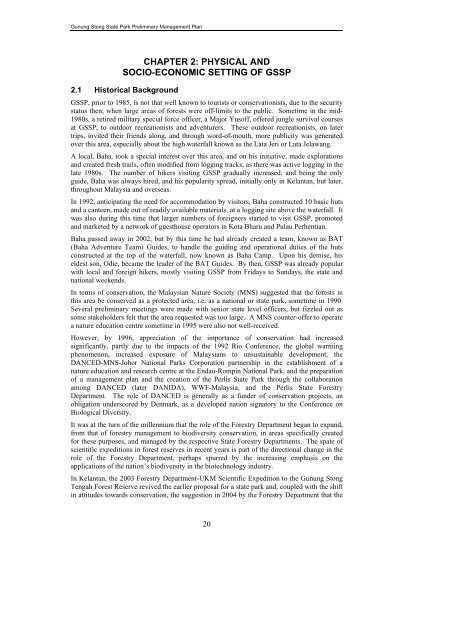FINAL VERSION FOR APPROVAL - Sdn Bhd - WWF Malaysia
FINAL VERSION FOR APPROVAL - Sdn Bhd - WWF Malaysia
FINAL VERSION FOR APPROVAL - Sdn Bhd - WWF Malaysia
Create successful ePaper yourself
Turn your PDF publications into a flip-book with our unique Google optimized e-Paper software.
Gunung Stong State Park Preliminary Management Plan<br />
CHAPTER 2: PHYSICAL AND<br />
SOCIO-ECONOMIC SETTING OF GSSP<br />
2.1 Historical Background<br />
GSSP, prior to 1985, is not that well known to tourists or conservationists, due to the security<br />
status then, when large areas of forests were off-limits to the public. Sometime in the mid-<br />
1980s, a retired military special force officer, a Major Yusoff, offered jungle survival courses<br />
at GSSP, to outdoor recreationists and adventurers. These outdoor recreationists, on later<br />
trips, invited their friends along, and through word-of-mouth, more publicity was generated<br />
over this area, especially about the high waterfall known as the Lata Jeri or Lata Jelawang.<br />
A local, Baha, took a special interest over this area, and on his initiative, made explorations<br />
and created fresh trails, often modified from logging tracks, as there was active logging in the<br />
late 1980s. The number of hikers visiting GSSP gradually increased, and being the only<br />
guide, Baha was always hired, and his popularity spread, initially only in Kelantan, but later,<br />
throughout <strong>Malaysia</strong> and overseas.<br />
In 1992, anticipating the need for accommodation by visitors, Baha constructed 10 basic huts<br />
and a canteen, made out of readily available materials, at a logging site above the waterfall. It<br />
was also during this time that larger numbers of foreigners started to visit GSSP, promoted<br />
and marketed by a network of guesthouse operators in Kota Bharu and Pulau Perhentian.<br />
Baha passed away in 2002, but by this time he had already created a team, known as BAT<br />
(Baha Adventure Team) Guides, to handle the guiding and operational duties of the huts<br />
constructed at the top of the waterfall, now known as Baha Camp. Upon his demise, his<br />
eldest son, Odie, became the leader of the BAT Guides. By then, GSSP was already popular<br />
with local and foreign hikers, mostly visiting GSSP from Fridays to Sundays, the state and<br />
national weekends.<br />
In terms of conservation, the <strong>Malaysia</strong>n Nature Society (MNS) suggested that the forests in<br />
this area be conserved as a protected area, i.e. as a national or state park, sometime in 1990.<br />
Several preliminary meetings were made with senior state level officers, but fizzled out as<br />
some stakeholders felt that the area requested was too large. A MNS counter-offer to operate<br />
a nature education centre sometime in 1995 were also not well-received.<br />
However, by 1996, appreciation of the importance of conservation had increased<br />
significantly, partly due to the impacts of the 1992 Rio Conference, the global warming<br />
phenomenon, increased exposure of <strong>Malaysia</strong>ns to unsustainable development, the<br />
DANCED-MNS-Johor National Parks Corporation partnership in the establishment of a<br />
nature education and research centre at the Endau-Rompin National Park, and the preparation<br />
of a management plan and the creation of the Perlis State Park through the collaboration<br />
among DANCED (later DANIDA), <strong>WWF</strong>-<strong>Malaysia</strong>, and the Perlis State Forestry<br />
Department. The role of DANCED is generally as a funder of conservation projects, an<br />
obligation underscored by Denmark, as a developed nation signatory to the Conference on<br />
Biological Diversity.<br />
It was at the turn of the millennium that the role of the Forestry Department began to expand,<br />
from that of forestry management to biodiversity conservation, in areas specifically created<br />
for these purposes, and managed by the respective State Forestry Departments. The spate of<br />
scientific expeditions in forest reserves in recent years is part of the directional change in the<br />
role of the Forestry Department, perhaps spurred by the increasing emphasis on the<br />
applications of the nation’s biodiversity in the biotechnology industry.<br />
In Kelantan, the 2003 Forestry Department-UKM Scientific Expedition to the Gunung Stong<br />
Tengah Forest Reserve revived the earlier proposal for a state park and, coupled with the shift<br />
in attitudes towards conservation, the suggestion in 2004 by the Forestry Department that the<br />
20
















